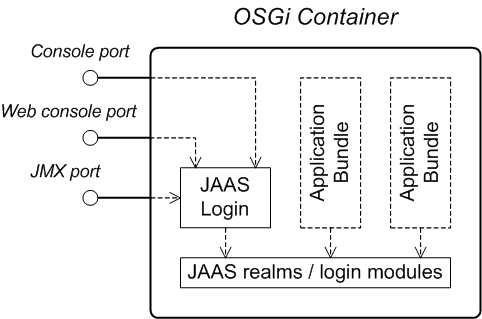Red Hat AMQ 6
As of February 2025, Red Hat is no longer supporting Red Hat AMQ 6. If you are using AMQ 6, please upgrade: Migrating to AMQ 7.Chapter 1. Security Architecture
Abstract
In the OSGi container, it is possible to deploy applications supporting a variety of security features. Currently, only the Java Authentication and Authorization Service (JAAS) is based on a common, container-wide infrastructure. Other security features are provided separately by the individual products and components deployed in the container.
1.1. OSGi Container Security
Copy linkLink copied to clipboard!
Overview
Copy linkLink copied to clipboard!
Figure 1.1, “OSGi Container Security Architecture” shows an overview of the security infrastructure that is used across the container and is accessible to all bundles deployed in the container. This common security infrastructure currently consists of a mechanism for making JAAS realms (or login modules) available to all application bundles.
Figure 1.1. OSGi Container Security Architecture
JAAS realms
Copy linkLink copied to clipboard!
A JAAS realm or login module is a plug-in module that provides authentication and authorization data to Java applications, as defined by the Java Authentication and Authorization Service (JAAS) specification.
Red Hat AMQ supports a special mechanism for defining JAAS login modules (in either a Spring or a blueprint file), which makes the login module accessible to all bundles in the container. This makes it easy for multiple applications running in the OSGi container to consolidate their security data into a single JAAS realm.
karaf realm
Copy linkLink copied to clipboard!
The OSGi container has a predefined JAAS realm, the
karaf realm. Red Hat AMQ uses the karaf realm to provide authentication for remote administration of the OSGi runtime, for the Fuse Management Console, and for JMX management. The karaf realm uses a simple file-based repository, where authentication data is stored in the InstallDir/etc/users.properties file.
You can use the
karaf realm in your own applications. Simply configure karaf as the name of the JAAS realm that you want to use. Your application then performs authentication using the data from the users.properties file.
Console port
Copy linkLink copied to clipboard!
You can administer the OSGi container remotely either by connecting to the console port with a Karaf client or using the Karaf
ssh:ssh command. The console port is secured by a JAAS login feature that connects to the karaf realm. Users that try to connect to the console port will be prompted to enter a username and password that must match one of the accounts from the karaf realm.
JMX port
Copy linkLink copied to clipboard!
You can manage the OSGi container by connecting to the JMX port (for example, using Java's JConsole). The JMX port is also secured by a JAAS login feature that connects to the
karaf realm.
Application bundles and JAAS security
Copy linkLink copied to clipboard!
Any application bundles that you deploy into the OSGi container can access the container's JAAS realms. The application bundle simply references one of the existing JAAS realms by name (which corresponds to an instance of a JAAS login module).
It is essential, however, that the JAAS realms are defined using the OSGi container's own login configuration mechanism—by default, Java provides a simple file-based login configuration implementation, but you cannot use this implementation in the context of the OSGi container.
